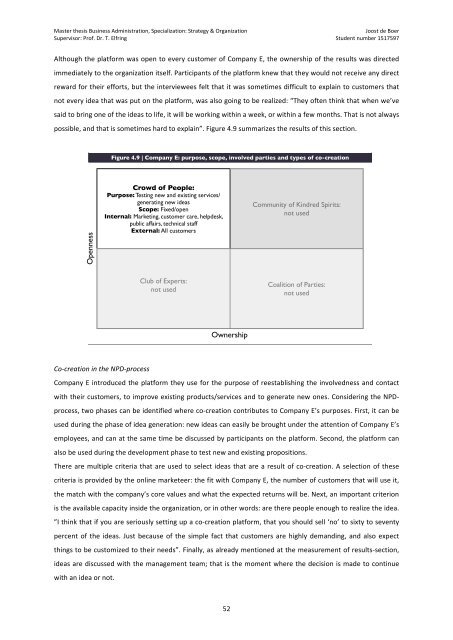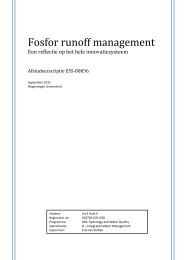Download PDF (English) - Future Ideas
Download PDF (English) - Future Ideas
Download PDF (English) - Future Ideas
You also want an ePaper? Increase the reach of your titles
YUMPU automatically turns print PDFs into web optimized ePapers that Google loves.
Master thesis Business Administration, Specialization: Strategy & Organization <br />
Supervisor: Prof. Dr. T. Elfring <br />
Joost de Boer <br />
Student number 1517597 <br />
Although the platform was open to every customer of Company E, the ownership of the results was directed <br />
immediately to the organization itself. Participants of the platform knew that they would not receive any direct <br />
reward for their efforts, but the interviewees felt that it was sometimes difficult to explain to customers that <br />
not every idea that was put on the platform, was also going to be realized: “They often think that when we’ve <br />
said to bring one of the ideas to life, it will be working within a week, or within a few months. That is not always <br />
possible, and that is sometimes hard to explain”. Figure 4.9 summarizes the results of this section. <br />
Figure 4.9 | Company E: purpose, scope, involved parties and types of co-creation<br />
Openness<br />
Crowd of People:<br />
Purpose: Testing new and existing services/<br />
generating new ideas<br />
Scope: Fixed/open<br />
Internal: Marketing, customer care, helpdesk,<br />
public affairs, technical staff<br />
External: All customers<br />
Community of Kindred Spirits:<br />
not used<br />
Club of Experts:<br />
not used<br />
Coalition of Parties:<br />
not used<br />
Ownership<br />
Co-‐creation in the NPD-‐process <br />
Company E introduced the platform they use for the purpose of reestablishing the involvedness and contact <br />
with their customers, to improve existing products/services and to generate new ones. Considering the NPD-process,<br />
two phases can be identified where co-‐creation contributes to Company E’s purposes. First, it can be <br />
used during the phase of idea generation: new ideas can easily be brought under the attention of Company E’s <br />
employees, and can at the same time be discussed by participants on the platform. Second, the platform can <br />
also be used during the development phase to test new and existing propositions. <br />
There are multiple criteria that are used to select ideas that are a result of co-‐creation. A selection of these <br />
criteria is provided by the online marketeer: the fit with Company E, the number of customers that will use it, <br />
the match with the company’s core values and what the expected returns will be. Next, an important criterion <br />
is the available capacity inside the organization, or in other words: are there people enough to realize the idea. <br />
”I think that if you are seriously setting up a co-‐creation platform, that you should sell ‘no’ to sixty to seventy <br />
percent of the ideas. Just because of the simple fact that customers are highly demanding, and also expect <br />
things to be customized to their needs”. Finally, as already mentioned at the measurement of results-‐section, <br />
ideas are discussed with the management team; that is the moment where the decision is made to continue <br />
with an idea or not. <br />
52





